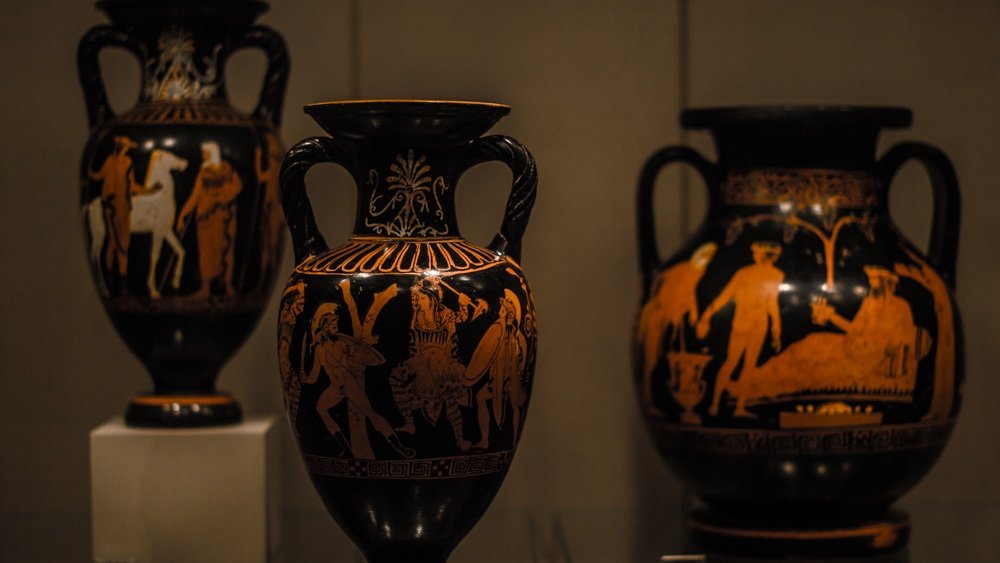How was pottery made in ancient Greece? 4 different types!
If you are a fan of pottery, there is no way you have not encountered a Greek piece of pottery at least once in your life. These pieces of art not only do reveal a huge amount of information that wouldn’t have been discovered otherwise but also gives us the chance to admire the style and skills used at its manufacturing. But how was pottery made in ancient Greece?
The process basically started just like today, by digging out clay from the earth and filtering from rocks. After mixing clay with water, the clay was put on a spinning wheel and enabling the potter to shape it accordingly. The firing of the pots was considered to be a complex process.
The most important factor that has given us the chance to study such a vast variety of different vessels is the fact that ancient Greeks had a much wider reliance on pottery vessels than vessels made of other materials due to their expensiveness of the banal lack of information. That was the period when it was very hard to use metals.
If you are interested in Ancient Greek pottery, this article is the best choice for you. Only here you will find out about the 4 types of Greek pottery, what materials were used to manufacture such wonderful vessels, and what technic was used to manufacture the well-known black/red-figure pottery.
What are Greek Vases Made Of?
Being one of the most indestructible yet accessible materials, clay was used to manufacture all the vases in Ancient Greece. It was not an easy process though.
First of all, the clay should have been separated from the small rocks and shells that would have messed up the final product and the vessel would not have been as fine and delicate as expected. This process can be done a lot of times until the clay becomes a lot smoother. The smoother clay becomes, the better and more expensive it will eventually be.
This material was used because of the lack of other materials. Keep in mind the fact that we are talking about the period when metals were used very rarely, and their main purpose was military.
Another fact that makes clay a great material is its indestructibility, if you don’t drop them on the floor, they will be just fine after tens of years of usage. On top of that, clay vessels that are fired at the right temperature are waterproof and won’t soft down if you keep water or wine in them.
The fact that ancient Greeks chose this material for their pottery has given us a chance to study their culture a lot better because, as I said previously, it is very hard to completely destroy such a vase. It would take a lot of time and power to manually ground them into dust to remove them from the archeological record. That is quite an accomplishment for such an early phase of humanity.
What are The Four Types of Greek Pottery?
In terms of decoration, Ancient Greek pottery has evolved into four major branches:
- Proto-geometric pottery
- Geometric pottery
- Black-figure pottery
- Red-figure pottery
1. Proto-Geometric Pottery
The oldest and most simple-designed type of Greek pottery, Proto-geometric pottery is reminiscent of earlier Greek civilizations of Minoan Crete and the Mycenean mainland. This type of pottery includes decorations that are made of simple shapes and forms that were directly taken from the Minoan and Mycenean styles.
Although the decorations did not vary a lot from their predecessors, the form of the vase was slightly changed. The center of gravity of the vase was moved towards the base of the vessel, making it more stable and spacious.
Although the designers of these vases were using all types of geometrical figures, the most commonly encountered shape was the triangle and the circle. A motif that endured for centuries was the upright triangular that became a staple feature of the black-figure pottery design later on.

2. Geometric Pottery
This type of pottery brings on stage finer pieces of art than the previous one. With the start of a new era, the clay that was used at the manufacturing of Geometric Pottery started to be smoother and a lot better to paint on, that is why, in another 100 years, along with the perfect geometrical figures, designers started to paint simple human figures, birds, and animals.
Another great design solution that makes a difference from other styles is the whole black lower part of the vessel.
With the start of this new era, the masters of pottery have started to use finer and finer materials combined with new techniques and better quality. The black stylized figures became more and more detailed, and the celebrated black-figure pottery style was born.
3. Black-Figure Pottery
This styled has amazed archaeologists around the world with its amazing attention to detail and colors. Although its named Black-Figure pottery, not only black paint was used to manufacture this kind of beauty.
Females for example were painted white, purple-red for accessories and clothes, and black only for males. A great interest in muscles and hair and other such small details has given this type of pottery the status of the most divine and famous styles of ancient Greek painting.
However, not only these details are making these designs outstanding. If you will look closely at one of the vessels, you will observe the fact that every figure has its posture and the finest figure are given grace and poise, you can literally see their movement through the paint and clay.
4. Red-Figure Pottery
This style does not differ much from the Black-Figure one. These styles were parallel for some time and there are even “bilingual” examples that are giving us a clear view of their slight but not important differences.
Red-Figure pottery has brought more realistic figures and a number of new colors that diversified the Black-Figure pottery. The designers have given facial expressions and postures even more attention than in the previous style and the designs became as realistic as possible for a pottery style.
How is Greek Black/Red-Figure Pottery Made?
The Greek black-figure pottery was taking a great amount of work and time to be done perfectly. The easiest part was the modeling of the vase. After that, the clay should have dried a little and the designer would start the painting of the main art using colored slip, a material that should turn black after the three-step firing of the vessel.
For some smaller details, the designers often used mineral colors, red and white, which will make the vessel more expensive and fine-looking. After the firing, the places where the designer applied the slip would turn black and the rest of the vessel would remain orange.
The red pottery technique is simply a reverse of the black figure pottery. Instead of blacking the characters and leaving the uncolored spaces for the background, red-pottery designers had started blacking out the background and leaving uncolored characters.










